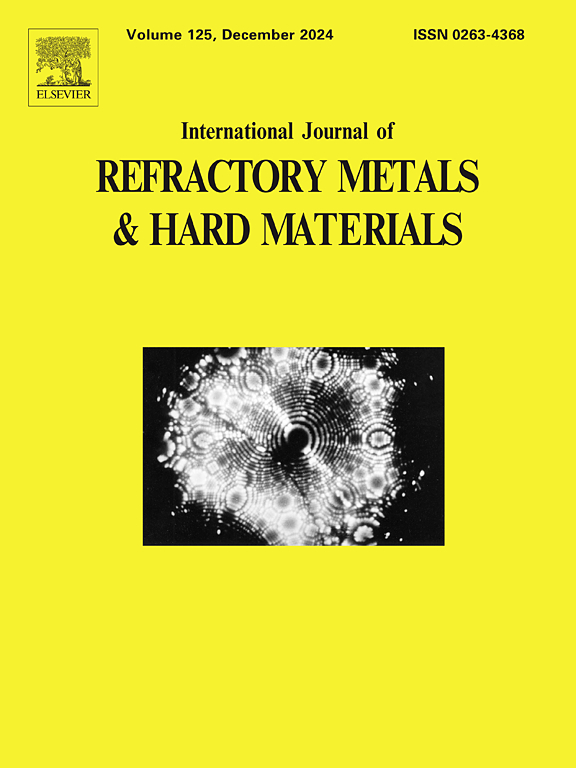The microstructure evolution and mechanical properties of WC-cu-10Ni-5Mn-3Sn cemented carbides containing NbC prepared by pressureless melt infiltration
IF 4.2
2区 材料科学
Q2 MATERIALS SCIENCE, MULTIDISCIPLINARY
International Journal of Refractory Metals & Hard Materials
Pub Date : 2024-10-23
DOI:10.1016/j.ijrmhm.2024.106929
引用次数: 0
Abstract
WC-based cemented carbides with different contents of NbC (0, 0.6, 0.8, 1.0, 1.2, and 1.4 wt%) are prepared via pressureless melt infiltration at 1200 °C for 1.5 h. Microstructure evolution regularity of WC-based cemented carbide is investigated to establish the effect of NbC addition and microstructure peculiarities on mechanical properties (flexural strength, hardness, and impact toughness) of final product. Experimental results reveal that NbC firstly dissolves in binder alloy during melt infiltration, which slows down dissolution-precipitation reaction of WC, thus refining WC grains. With the increase in NbC content, average WC grain size shows varying trend, achieving the minimum (3.779 μm) at NbC addition of 1 wt%. When NbC is added in smaller amounts, Nb is mainly distributed throughout binder alloy. With the increase in NbC content, Nb elements tend to form aggregates and attach to WC particle boundaries. Some WC and NbC also decompose under experimental conditions. At NbC addition greater than 1 wt%, decomposition products (Nb, W, and C) combine with other elements in binder phase to form new phases such as (Nb,W)C, Ni2W4C, Nb2C, and Nb4Ni2C. These phases further act as bridges for WC grain coarsening. Meanwhile, excessive NbC is detrimental to mechanical properties of the alloy. With the increase in NbC content, hardness and flexural strength of the alloy increase and then decrease, reaching the maximum values of 93.4 HRA and 1808.786 MPa, respectively, at 1 wt% NbC addition. In turn, impact toughness of the alloy shows consistently downward trend. Therefore, changes in mechanical properties of WC-based cemented carbides are mainly related to WC grain size, the appearance of new phases in binder phase, and their morphology.
无压熔渗制备的含 NbC 的 WC-cu-10Ni-5Mn-3Sn 硬质合金的微观结构演变和力学性能
在 1200 °C、1.5 小时的无压熔渗条件下制备了不同 NbC 含量(0、0.6、0.8、1.0、1.2 和 1.4 wt%)的碳化钨基硬质合金,并研究了碳化钨基硬质合金微观结构演变的规律性,以确定 NbC 添加量和微观结构特性对最终产品机械性能(抗弯强度、硬度和冲击韧性)的影响。实验结果表明,在熔体渗入过程中,NbC 首先溶解在粘结剂合金中,减缓了碳化钨的溶解沉淀反应,从而细化了碳化钨晶粒。随着 NbC 含量的增加,WC 的平均晶粒大小呈变化趋势,当 NbC 添加量为 1 wt% 时,晶粒大小最小(3.779 μm)。当 NbC 的添加量较少时,铌主要分布在整个粘结剂合金中。随着 NbC 含量的增加,铌元素倾向于形成聚集体并附着在 WC 颗粒边界上。在实验条件下,一些 WC 和 NbC 也会分解。当 NbC 的添加量超过 1 wt%时,分解产物(Nb、W 和 C)与粘结剂相中的其他元素结合形成新的相,如 (Nb,W)C、Ni2W4C、Nb2C 和 Nb4Ni2C。这些相进一步成为 WC 晶粒粗化的桥梁。同时,过量的 NbC 会损害合金的机械性能。随着 NbC 含量的增加,合金的硬度和抗弯强度先增大后减小,当 NbC 含量为 1 wt% 时,硬度和抗弯强度分别达到 93.4 HRA 和 1808.786 MPa 的最大值。而合金的冲击韧性则呈持续下降趋势。因此,WC 基硬质合金机械性能的变化主要与 WC 晶粒大小、粘结相中新相的出现及其形态有关。
本文章由计算机程序翻译,如有差异,请以英文原文为准。
求助全文
约1分钟内获得全文
求助全文
来源期刊
CiteScore
7.00
自引率
13.90%
发文量
236
审稿时长
35 days
期刊介绍:
The International Journal of Refractory Metals and Hard Materials (IJRMHM) publishes original research articles concerned with all aspects of refractory metals and hard materials. Refractory metals are defined as metals with melting points higher than 1800 °C. These are tungsten, molybdenum, chromium, tantalum, niobium, hafnium, and rhenium, as well as many compounds and alloys based thereupon. Hard materials that are included in the scope of this journal are defined as materials with hardness values higher than 1000 kg/mm2, primarily intended for applications as manufacturing tools or wear resistant components in mechanical systems. Thus they encompass carbides, nitrides and borides of metals, and related compounds. A special focus of this journal is put on the family of hardmetals, which is also known as cemented tungsten carbide, and cermets which are based on titanium carbide and carbonitrides with or without a metal binder. Ceramics and superhard materials including diamond and cubic boron nitride may also be accepted provided the subject material is presented as hard materials as defined above.

 求助内容:
求助内容: 应助结果提醒方式:
应助结果提醒方式:


